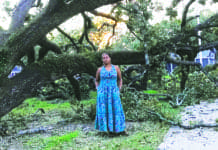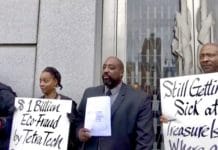
by Ahimsa Porter Sumchai, M.D.
“The exposures did result in some increased risk for community residents, although it is not possible to quantify this risk.” – Thomas Sinks, Ph.D., deputy director, Agency for Toxic Substances Disease Registry
“Prior to the ATSDR cover letter coming out, there seemed to be an indication that due to political realities, ATSDR would not be able to help much with the asbestos issue. Lennar was on a fast track.” – Agenda topic at a meeting of ATSDR, CDPH (California Department of Public Health), EPA (U.S. Environmental Protection Agency) and community coalition members at the EPA Region 9 Conference Center on Nov. 13, 2007
Thomas Sinks, Ph.D., is the deputy director of the National Center for Environmental Health, a division of the Agency for Toxic Substances and Disease Registry of the U.S. Centers for Disease Control and Prevention. Sinks is the subject of a congressional investigation launched last month after an investigation by CBS News revealed he may have bowed to corporate and political pressure to conceal the hazardous effects of toxic beryllium dust exposure on residents of a small town in Ohio.
Many of you will remember Dr. Sinks. He led the sloppy investigation into the community exposures to toxic dust which occurred at Lennar Corp.’s grading and excavation operations at Hunters Point Shipyard Parcel A in San Francisco last fall. Not a single Hunters Point resident who had been exposed to the dust and was suffering symptoms that could be caused by the exposure was medically evaluated or interviewed for the ATSDR report.
Did Dr. Sinks bow to corporate and political pressure to conceal the hazardous effects of toxic asbestos-containing dust on residents of the Bayview Hunters Point District in San Francisco? In Elmore, Ohio, pressure had apparently come from the material engineering company Brush Wellman, operator of the world’s largest beryllium manufacturing plant, which generates toxic beryllium dust. In Hunters Point, pressure apparently comes from the Lennar Corp., one of the nation’s largest homebuilders. Its grading and excavation activities generate toxic asbestos dust.
According to a San Francisco Department of Public Health (SFDPH) memorandum dated June 2007, there were complaints about dust from the very beginning of Lennar’s grading activities in April of 2006. The California Department of Public Health (CDPH) reviewed asbestos monitoring data collected between Aug. 3, 2006, and Aug. 19, 2007. No asbestos monitoring data was available from April 25, 2006, through Aug. 2, 2006. In 2006, SFDPH issued three Notices of Violation to the developer concerning the generation of visible dust.
On July 17, 2007, Dr. Rajiv Bhatia, director of Occupational and Environmental Health for the San Francisco Department of Public Health, requested that ATSDR review and interpret the incomplete logs of air monitoring data, analyze data gaps and evaluate judgments made by SFDPH about the health impacts and significance of exposure to naturally occurring asbestos in the community.
The analysis was completed by the California Department of Public Health (CDPH) on Sept. 10, 2007, and directed to Capt. Susan L. Muza, regional head of ATSDR. Capt. Muza, who met with community leaders in August of 2007, was asked by Minister Christopher Muhammad to recommend a temporary halt to Lennar’s construction activities while the ATSDR investigation was underway. Muza made an off-line comment suggesting that the agency had to accept “political realities” in dealing with “political monsters.”
The report conducted by the Site Assessment Section of the CDPH for ATSDR reports that “the contractor exceeded the Bay Area Air Quality Management District asbestos action level that triggers work stoppage on 13 percent of excavation days, and because there have been complaints about dust which may cause health concerns, SFDPH should assign a person to continuously monitor dust production and dust abatement during working hours.”
Mayor Gavin Newsom, whose conflict of interest relationships with Lennar have now been reported to the Ethics Commission, the FBI and the U.S. Attorney’s office, trumpeted his gratitude to the CDC and the ATSDR for their report and attention to the matter: “We are heartened by the fact that the CDC and the California Department of Public Health agree with the San Francisco Department of Public Health [that] there was no significant health risk created by the grading activities at the Shipyard.”
Dr. Sinks, in fact, concluded in his cover letter to the SFDPH that “there was clear evidence that levels of asbestos exceeded the mandated thresholds at both the fence line and in the community. The concentrations of dust could not be interpreted because of the sampling methods and … the exposures did result in some increased risk for community residents, although it is not possible to quantify this risk.”
In a Community Health Update flyer funded by Lennar Urban and widely distributed to a hearing before the San Francisco School Board in October of 2007 – where dozens of parents, teachers, administrators and buildings and grounds supervisors testified that toxic dust from the grading activities on Parcel A was causing headaches, nosebleeds, asthma, bronchitis and declining school performance – the African American Community Revitalization Consortium parroted Gavin Newsom in concluding: “The Agency for Toxic Substances and Disease Registry, a division of the U.S. Centers for Disease Control and Prevention, recently concluded that grading operations at the Hunters Point Shipyard pose no significant health risk to residents in Bayview Hunters Point.”
Particle pollution
San Francisco Department of Public Health programs in Bayview Hunters Point identified on Sept. 19, 2006, by city Health Director Mitchell H. Katz, M.D., include “DPH activities to improve environmental quality in Bayview Hunters Point; Mapping noise and air quality for better land use; and Support citywide project to safely locate new electricity generating units.”
In an undated “Fact Sheet” from Dr. Katz mailed to residents of Bayview Hunters Point in 2007, Katz’ statement begins: “You may have heard there are reasons to worry about your health because of the construction dust generated by the redevelopment of Parcel A of the Hunters Point Shipyard. That is not true.”
“Dust does not cause asthma,” Dr. Katz declared during a power point presentation to the San Francisco Board of Supervisors opposing a resolution to halt Lennar’s grading and construction activities in October 2007.
Did Dr. Sinks bow to corporate and political pressure to conceal the hazardous effects of toxic asbestos-containing dust on residents of the Bayview Hunters Point District in San Francisco?
According to the U.S. Environmental Protection Agency Office of Air and Radiation, airborne particles, the main ingredient of haze, smoke and airborne dust, presents serious air quality problems in many areas of the United States. This particle pollution can occur year round and can cause a number of serious health problems, even at concentrations found in many major cities.
In a new air-quality report card entitled “State of the Air 2007,” San Francisco received a “big fat F” for particulate pollution, according to Linda Weiner, director of research for the American Lung Association.
Particle pollution is a mixture of microscopic solids and liquid droplets suspended in air. This pollution, also known as particulate matter, is made up of a number of components, including acids, organic chemicals, metals, soil or dust particles and fragments of pollen or mold spores.
The size of particles is directly linked to their potential for causing health problems. Small particles less than 10 micrometers in diameter pose the greatest problems because they can get deep into your lungs and into your bloodstream. Exposure to such particles can affect both your lungs and your heart. Larger particles are of less concern, although they can irritate your eyes, nose and throat.
Small particles, called fine particulates, are 2.5 micrometers in diameter, and coarse particles, such as those found in windblown dust, have diameters between 2.5 and 10 micrometers.
People with heart or lung disease, older adults and children are considered at greater risk from particles, especially when they are physically active. Exercise and physical activity cause people to breathe faster and more deeply and take more particles into their lungs.
Short term exposures to particles can, within hours or days, aggravate lung disease, cause asthma attacks and acute bronchitis and increase susceptibility to respiratory infections. In people with heart disease, short term exposures have been linked to heart attacks and arrhythmias.
People with heart or lung disease such as coronary artery disease, congestive heart failure, asthma or COPD (Chronic Obstructive Pulmonary Disease) are at increased risk because particles can aggravate these diseases.
Scientists are evaluating new studies that suggest exposure to high particle levels may be associated with low birth weight infants, pre-term deliveries and fetal and infant deaths.
Particle pollution is a toxic air contaminant of major concern these days. The three combustion turbine “peaker” power plants the San Francisco Public Utilities Commission is aggressively maneuvering to position in southeast San Francisco north of Islais Creek with the bold assistance of Health Director Mitch Katz and Supervisor Sophie Maxwell, emit greater levels of fine particulates than does the existing Mirant power plant.
Over 600 people have been documented to have experienced respiratory symptoms following the spraying of a pheromone compound encapsulated in a plastic coarse particulate in Monterey and Santa Cruz regions.
Officials in Beijing, China, have ordered a halt to construction and industrial activities in the city to improve the air quality and reduce particulate emissions for endurance athletes expected to compete in the Olympics this August.
In the days following the Sept. 11, 2001, destruction of the twin towers of the World Trade Center, Lower Manhattan was enveloped in dust clouds rising over 1,000 feet. Rescue workers and residents were subjected to a cocktail of gases and airborne particulates that led to a public health catastrophe the EPA, with help from FEMA and OSHA, attempted to conceal.
At that time, EPA assured New Yorkers the dust and smoke emanating from Ground Zero posed no health risk. EPA issued five press releases within 10 days of the attack assuring the public the air was safe to breathe.
On March 10, 2004, a class action lawsuit was filed against the U.S. Environmental Protection Agency on behalf of residents, students and workers exposed to post 9/11 airborne toxins demanding that defendants fund “a medical monitoring program which includes testing and preventive screening for conditions resulting from exposure to World Trade Center toxic dust.”
What you can do

If you suspect a similar coverup in Hunters Point, write to the following government officials and journalists: Capt. Susan L. Muza, regional head of the Agency for Toxic Substances Disease Registry, at Muza.susan@epamail.epa.gov; Thomas Sinks, Ph.D., deputy director of the ATSDR at Tsinks@cdc.gov; Mitchell H. Katz, M.D., director of the San Francisco Department of Public Health at Mitch.katz@sfdph.org; Rajiv Bhatia, M.D., director of Occupational and Environmental Health for the San Francisco DPH at Rajiv.bhatia@sfdph.org; Jack Broadbent, CEO of the Bay Area Air Quality Management District at Jbroadbent@baaqmd.gov; San Francisco Chronicle writer Jane Kay at Jkay@sfchronicle.com; and San Francisco Examiner writer Bonnie Eslinger at Beslinger@examiner.com.
Contact Dr. Sumchai at (415) 835-4763 or asumchai@sfbayviewnews.wpenginepowered.com.

 Store
Store












